Astronomical Forcing of Fine-Grained Sedimentary Rocks and Its Implications for Shale Oil and Gas Exploration: The BONAN Sag, Bohai Bay Basin, China
Abstract
1. Introduction
2. Regional Geological Overview
3. Data and Methods
3.1. Data Selection
3.2. Astronomical Cycle Solutions
4. Results
4.1. Cyclostratigraphic Analysis
4.1.1. Theoretical Astronomical Period
4.1.2. Deep-Domain Spectrum Analysis
4.1.3. Optimal Sedimentation Rate Estimation
4.1.4. Filtering and Tuning
4.2. Astronomical Cycle Stratigraphic Division
4.2.1. GR Curve and Lithological Characteristics
4.2.2. Single Well Astronomical Cycle Stratigraphic Division
4.2.3. Stratigraphic Correlation of Connected Wells
4.2.4. Depositional Evolution of Sandstone Interbedded Mudrock Reservoirs
5. Discussion
5.1. Analysis of the Depositional Evolution of Sandstone-Interbedded Mudrock Driven by Astronomical Force
5.2. The Petroleum Geological Significance of Astronomical Cycle Analysis
6. Conclusions
- (1)
- The sedimentary cycle periods and optimal sedimentation rates were obtained. Utilizing GR as a proxy, spectral analysis has illuminated the intricate sedimentary cycles within the Es3l sub-member in the Bonan Sag. These cycles encompass periods of 405, 100, 51, 40, 22, and 19 ka. Notably, the stratigraphic thickness modulated by the 405 ka long eccentricity reaches approximately 38.9 m, whereas the 97 ka short eccentricity governs a thickness of roughly 9.7 m. The 51 ka and 40 ka obliquity constrain the thickness to a range of 3.7 to 3.4 m, and the 22 ka and 19 ka precessions further limit it to 1.96 to 1.66 m. Through the application of the “COCO” (Correlation Coefficient) method, the optimal deposition rate for the Es3l sub-member has been calculated to be 8.39 cm/ka. Leveraging magnetic stratigraphic data, we have anchored the ages of the top and bottom boundaries at 40.20 Ma and 42.47 Ma, respectively, and subsequently constructed a “floating” astronomical timescale for Well JYC1, utilizing the 100 ka long eccentricity filtered curve as a reference.
- (2)
- Different cycles, including long-eccentricity, obliquity, and precession cycles, were delineated, serving as the basis for stratigraphic division. When conducting astronomical cycle stratigraphic division for single wells in the Es3l of the Bonan Sag, it was found that there were consistently 6 long-eccentricity cycles, 25 short-eccentricity cycles with a slope of approximately 56, and about 104 precession cycles. During well-to-well stratigraphic correlation, within the 405 ka long-eccentricity cycle, stratigraphic division was conducted using a 100 ka short-eccentricity filtered curve, resulting in the identification of approximately 25 short-eccentricity cycles. This approach achieved high-precision stratigraphic division and correlation.
- (3)
- It has been discovered that the synergistic effect of short eccentricity and precession controls the quality of sandstone-interbedded mudrock. Specifically, higher eccentricity values are associated with the development of thicker sandstone interbeds, while minimal precession values tend to enhance the thickness of these sandstone interbeds. Through astronomical cycle analysis, the depositional evolution mechanisms of sandstone-interbedded mudrock have been unveiled. Combining these insights with high-precision stratigraphic classification results provides a basis for detailed evaluation of lacustrine shale oil reservoirs and prediction of “sweet spots”.
Author Contributions
Funding
Data Availability Statement
Conflicts of Interest
References
- Aplin, A.C.; Macquaker, J.H.S. Mudstone diversity: Origin and implications for source, seal, and reservoir properties in petroleum systems. AAPG Bull. 2011, 95, 2031–2059. [Google Scholar] [CrossRef]
- Jiang, Z.; Liang, C.; Wu, J.; Zhang, J.G.; Zhang, W.Z.; Wang, Y.S.; Liu, H.M.; Chen, X. Several problems in the study of fine-grained sedimentary rocks containing oil and gas. Acta Pet. Sin. 2013, 34, 1031–1039, (In Chinese with English abstract). [Google Scholar]
- Yan, J.; Yan, Y.; Peng, J.; Li, Z.; Geng, B.; Lai, F. Relationship between astrostratigraphy and cycle stratigraphy, research progress and significance. Lithol. Reserv. 2017, 29, 147–156, (In Chinese with English abstract). [Google Scholar]
- Zou, C.; Zhu, R.; Wu, S.; Yang, Z.; Tao, S.; Yuan, X.; Hou, L.; Yang, H.; Yang, C.; Li, D.; et al. Conventional and unconventional oil and gas accumulation types, characteristics, mechanisms and Prospects—A case study of tight oil and tight gas in China. Acta Pet. Sin. 2012, 33, 173–187, (In Chinese with English abstract). [Google Scholar]
- Yan, J.P.; Liang, Q.; Geng, B.; Feng, C.Z.; Kou, X.P.; Hu, Y. Well logging calculation method and application of geochemical parameters of lacustrine shale—Taking the lower member of Es3 in Bonan sag of Zhanhua sag as an example. Lithol. Reserv. 2017, 29, 108–116, (In Chinese with English abstract). [Google Scholar]
- Zhao, X.Z.; Zhou, L.H.; Pu, X.G.; Jin, M.F.; Shi, Z.N.; Xiao, D.Q.; Han, W.Z.; Jiang, W.Y.; Zhang, W.; Wang, H. Favorable Conditions for Formation and Enrichment of Lacustrine Shale Oil in Faulted Lake Basin: A Case Study of the Second Member of Kongdian Formation in Cangdong Sag, Bohai Bay Basin. Acta Pet. Sin. 2019, 40, 1013–1029, (In Chinese with English abstract). [Google Scholar]
- Zhang, J.G.; Jiang, Z.X.; Liu, L.A.; Yuan, F.; Feng, L.Y.; Li, C.S. Lithofacies and depositional evolution of fine grained sedimentary rocks in the lower submember of the Member 3 of Shahejie Formation in Zhanhua sag, Bohai Bay Basin. Acta Pet. Sin. 2021, 42, 293–306, (In Chinese with English abstract). [Google Scholar]
- Boulila, S.; Galbrun, B.; Huret, E.; Hinnov, L.A.; Rouget, I.; Gardin, S.; Bartolini, A. Astronomical calibration of the Toarcian Stage: Implications for sequence stratigraphy and duration of the early Toarcian OAE. Earth Planet. Sci. Lett. 2014, 386, 98–111. [Google Scholar] [CrossRef]
- Shi, J.; Jin, Z.; Liu, Q.; Huang, Z. Depositional process and astronomical forcing model of lacustrine fine-grained sedimentary rocks: A case study of the early Paleogene in the Dongying Sag, Bohai Bay Basin. Mar. Pet. Geol. 2020, 113, 103995. [Google Scholar] [CrossRef]
- Berger, A. Milankovitch, the father of paleoclimate modeling. Clim. Past 2021, 17, 1727–1733. [Google Scholar] [CrossRef]
- Berger, A. Milankovitch theory and climate. Rev. Geophys. 1988, 26, 624–657. [Google Scholar] [CrossRef]
- Weedon, G.P. Time-Series Analysis and Cyclostratigraphy; Cambridge University Press: Cambridge, UK, 2003; pp. 10–14. [Google Scholar]
- Strasser, A.H.; Heckel, P.H. Cyclostratigraphy concepts, definitions, and applications. Newsl. Stratigr. 2007, 42, 75–114. [Google Scholar] [CrossRef]
- Huang, C.J. The current status of cyclostratigraphy and astrochronology in the Mesozoic. Geosci. Front. 2014, 21, 48–66. [Google Scholar]
- Wu, H.C.; Zhang, S.H.; Feng, Q.L.; Fang, N.Q.; Yang, T.S.; Li, H.Y. Theoretical Basis, Research Progress and Prospect of Cycle Stratigraphy. J. Earth Sci. (J. China Univ. Geosci.) 2011, 36, 409–428, (In Chinese with English abstract). [Google Scholar]
- Jin, Z.H.; Jiang, Z.X.; Zhang, J.G.; Liu, S.Q.; Chen, J.; Zhao, L.J.; Lei, H.R. Study on cycle stratigraphy of the upper Es4 member in Dongying depression—Taking well Fanye 1 as an example. Sci. Technol. Eng. 2017, 17, 21–28, (In Chinese with English abstract). [Google Scholar]
- Zhang, J.; Jiang, Z.; Liang, C.; Baars, T.F.; Wang, Y.; Abels, H.A. Astronomical forcing of meter-scale organic-rich mudstone–limestone cyclicity in the Eocene Dongying sag, China: Implications for shale reservoir exploration. AAPG Bull. 2022, 106, 1557–1579. [Google Scholar] [CrossRef]
- Kietzmann, D.A.; Palma, R.M.; Iglesia Llanos, M.P. Cyclostratigraphy of an orbitally-driven Tithonian–Valanginian carbonate ramp succession, Southern Mendoza, Argentina: Implications for the Jurassic–Cretaceous boundary in the Neuquén. Basin. Sediment. Geol. 2015, 315, 29–46. [Google Scholar] [CrossRef]
- Fang, Q.; Wu, H.; Hinnov, L.A.; Wang, X.; Yang, T.; Li, H.; Zhang, S. A record of astronomically forced climate change in a late Ordovician (Sandbian) deep marine sequence, Ordos Basin, North China. Sediment. Geol. 2016, 341, 163–174. [Google Scholar] [CrossRef]
- Abels, H.A.; Abdul Aziz, H.; Calvo, J.P.; Tuenter, E. Shallow lacustrine carbonate microfacies document orbitally paced lake-level history in the Miocene Teruel Basin (North-East Spain). Sedimentology 2009, 56, 399–419. [Google Scholar] [CrossRef]
- Abels, H.A.; Aziz, H.A.; Ventra, D.; Hilgen, F.J. Orbital Climate Forcing in Mudflat to Marginal Lacustrine Deposits in the Miocene Teruel Basin (Northeast Spain). J. Sediment. Res. 2009, 79, 831–847. [Google Scholar] [CrossRef]
- Ocakoğlu, F.; Açıkalın, S.; Yılmaz, İ.Ö.; Şafak, Ü.; Gökçeoğlu, C. Evidence of orbital forcing in lake-level fluctuations in the Middle Eocene oil shale-bearing lacustrine successions in the Mudurnu-Göynük Basin, NW Anatolia (Turkey). J. Asian Earth Sci. 2012, 56, 54–71. [Google Scholar] [CrossRef]
- Wu, H.; Zhang, S.; Jiang, G.; Hinnov, L.; Yang, T.; Li, H.; Wan, X.; Wang, C. Astrochronology of the Early Turonian–Early Campanian terrestrial succession in the Songliao Basin, northeastern China and its implication for long-period behavior of the Solar System. Palaeogeogr. Palaeoclimatol. Palaeoecol. 2013, 385, 55–70. [Google Scholar] [CrossRef]
- Yang, Y.; Miall, A.D. Migration and stratigraphic fill of an underfilled foreland basin: Middle–Late Cenomanian Belle Fourche Formation in southern Alberta, Canada. Sediment. Geol. 2010, 227, 51–64. [Google Scholar] [CrossRef]
- Zhao, K.; Du, X.; Lu, Y.; Xiong, S.; Wang, Y. Are light-dark coupled laminae in lacustrine shale seasonally controlled? A case study using astronomical tuning from 42.2 to 45.4 Ma in the Dongying Depression, Bohai Bay Basin, eastern China. Palaeogeogr. Palaeoclimatol. Palaeoecol. 2019, 528, 35–49. [Google Scholar] [CrossRef]
- Zhao, X.X.; Yan, J.P.; Wang, M.; He, X.; Zhong, G.H.; Wang, J.; Geng, B.; Hu, Q.H.; Li, Z.P. Characteristics of lacustrine shale intercalation in Shahejie Formation of Zhanhua Depression and logging identification method. Lithol. Reserv. 2022, 34, 118–129, (In Chinese with English abstract). [Google Scholar]
- Zhou, L.H.; Pu, X.G.; Deng, Y.; Chen, S.Y.; Yan, J.H.; Han, W.Z. Several noteworthy problems in the study of fine-grained sedimentary rocks. Lithol. Reserv. 2016, 28, 6–15, (In Chinese with English abstract). [Google Scholar]
- Tavakoli, V. Application of gamma deviation log (GDL) in sequence stratigraphy of carbonate strata, an example from offshore Persian Gulf, Iran. J. Pet. Sci. Eng. 2017, 156, 868–876. [Google Scholar] [CrossRef]
- Prokoph, A.; Villeneuve, M.; Agterberg, F.P.; Rachold, V. Geochronology and calibration of global Milankovitch cyclicity at the Cenomanian-Turonian boundary. Geology 2001, 29, 523–526. [Google Scholar] [CrossRef]
- Jia, S.; Jiang, Z.X.; Zhang, W.Z. Characteristics and controlling factors of shale oil reservoir in Zhanhua Depression. Mar. Geol. Front. 2018, 34, 29–38, (In Chinese with English abstract). [Google Scholar]
- Liu, H.; Yuan, F.F.; Jiang, Y.L.; Hao, X.F.; Fang, X.Q. Overpressure characteristics and genetic mechanism of Paleogene in Zhanhua Depression. J. China Univ. Pet. (Ed. Nat. Sci.) 2021, 45, 23–32, (In Chinese with English abstract). [Google Scholar]
- Li, C.; Zhu, X.M.; Zhu, S.F.; Geng, M.Y.; Bi, Y.Q.; Shu, Q.L.; Xu, F.G. Characteristics of shale reservoirs in the lower Es3 formation in Luojia area of Zhanhua Depression. Acta Sedimentol. Sin. 2015, 33, 795–808, (In Chinese with English abstract). [Google Scholar]
- Li, M.; Hinnov, L.; Kump, L. Acycle: Time-series analysis software for paleoclimate research and education. Comput. Geosci. 2019, 127, 12–22. [Google Scholar] [CrossRef]
- Cleveland, W.S. Robust locally weighted regression and smoothing scatterplots. J. Am. Stat. Assoc. 1979, 74, 829–836. [Google Scholar] [CrossRef]
- Laskar, J.; Fienga, A.; Gastineau, M.; Manche, H. A new orbital solution for the long-term motion of the Earth. Astron. Astrophys. 2011, 532, 77–89. [Google Scholar] [CrossRef]
- Fienga, A.; Laskar, J.; Morley, T.; Manche, H.; Kuchynka, P.; Poncin-Lafitte, C.L.; Budnik, F.; Gastineau, M.; Somenzi, L. INPOP08, a 4-D planetary ephemeris: From asteroid and time-scale computations to ESA mars express and venus express contributions. Astron. Astrophys. 2009, 507, 1675–1686. [Google Scholar] [CrossRef]
- Liu, Z.; Huang, C.; Algeo, T.J.; Liu, H.; Hao, Y.; Du, X.; Lu, Y.; Chen, P.; Guo, L.; Peng, L. High-resolution astrochronological record for the Paleocene-Oligocene (66–23 Ma) from the rapidly subsiding Bohai Bay Basin, northeastern China. Palaeogeogr. Palaeoclimatol. Palaeoecol. 2018, 510, 78–92. [Google Scholar] [CrossRef]
- Zhang, R.L.; Jin, S.D. Cycle stratigraphy of the lower Es3 member in well Luo 69 in Zhanhua sag, Bohai Bay Basin. J. Cent. South Univ. (Sci. Technol.) 2021, 52, 1516–1531, (In Chinese with English abstract). [Google Scholar]
- Meyers, S.R.; Sageman, B.B.; Hinnov, L.A. Integrated quantitative stratigraphy of the cenomanian-turonian bridge creek limestone member using evolutive harmonic analysis and stratigraphic modeling. J. Sediment. Res. 2001, 71, 628–644. [Google Scholar] [CrossRef]
- Meyers, S.R. Seeing red in cyclic stratigraphy: Spectral noise estimation for astrochronology. Paleoceanography 2012, 27, PA3228. [Google Scholar] [CrossRef]
- Ma, C.; Meyers, S.R.; Sageman, B.B.; Singer, B.S.; Jicha, B.R. Testing the astronomical time scale for oceanic anoxic event 2, and its extension into Cenomanian strata of the Western Interior Basin (USA). Geol. Soc. Am. Bull. 2014, 126, 974–989. [Google Scholar] [CrossRef]
- Zhang, J.G.; Jiang, Z.X.; Liu, P.; Kong, X.X.; Ge, Y.J. Deposition mechanism and geological assessment of continentaultrafine grained shale oil reservoirs. Acta Pet. Sin. 2022, 43, 234–249, (In Chinese with English abstract). [Google Scholar]
- Tuenter, E.; Weber, S.L.; Hilgen, F.J.; Lourens, L.J. The response of the African summer monsoon to remote and local forcing due to precession and obliquity. Glob. Planet. Change 2003, 36, 219–235. [Google Scholar] [CrossRef]
- Abels, H.A.; Kraus, M.J.; Gingerich, P.D.; Sheldon, N. Precession-scale cyclicity in the fluvial lower Eocene Willwood Formation of the Bighorn Basin, Wyoming (USA). Sedimentology 2013, 60, 1467–1483. [Google Scholar] [CrossRef]
- Huang, C.; Hinnov, L.; Fischer, A.G.; Grippo, A.; Herbert, T. Astronomical tuning of the Aptian Stage from Italian reference sections. Geology 2010, 38, 899–902. [Google Scholar] [CrossRef]
- Zachos, J.; Pagani, M.; Sloan, L.; Thomas, E.; Billups, K. Trends, Rhythms, and Aberrations in Global Climate 65 Ma to Present. Science 2001, 292, 686–693. [Google Scholar] [CrossRef]
- Valero, L.; Garcés, M.; Cabrera, L.; Costa, E.; Sáez, A. 20 Myr of eccentricity paced lacustrine cycles in the Cenozoic Ebro Basin. Earth Planet. Sci. Lett. 2014, 408, 183–193. [Google Scholar] [CrossRef]
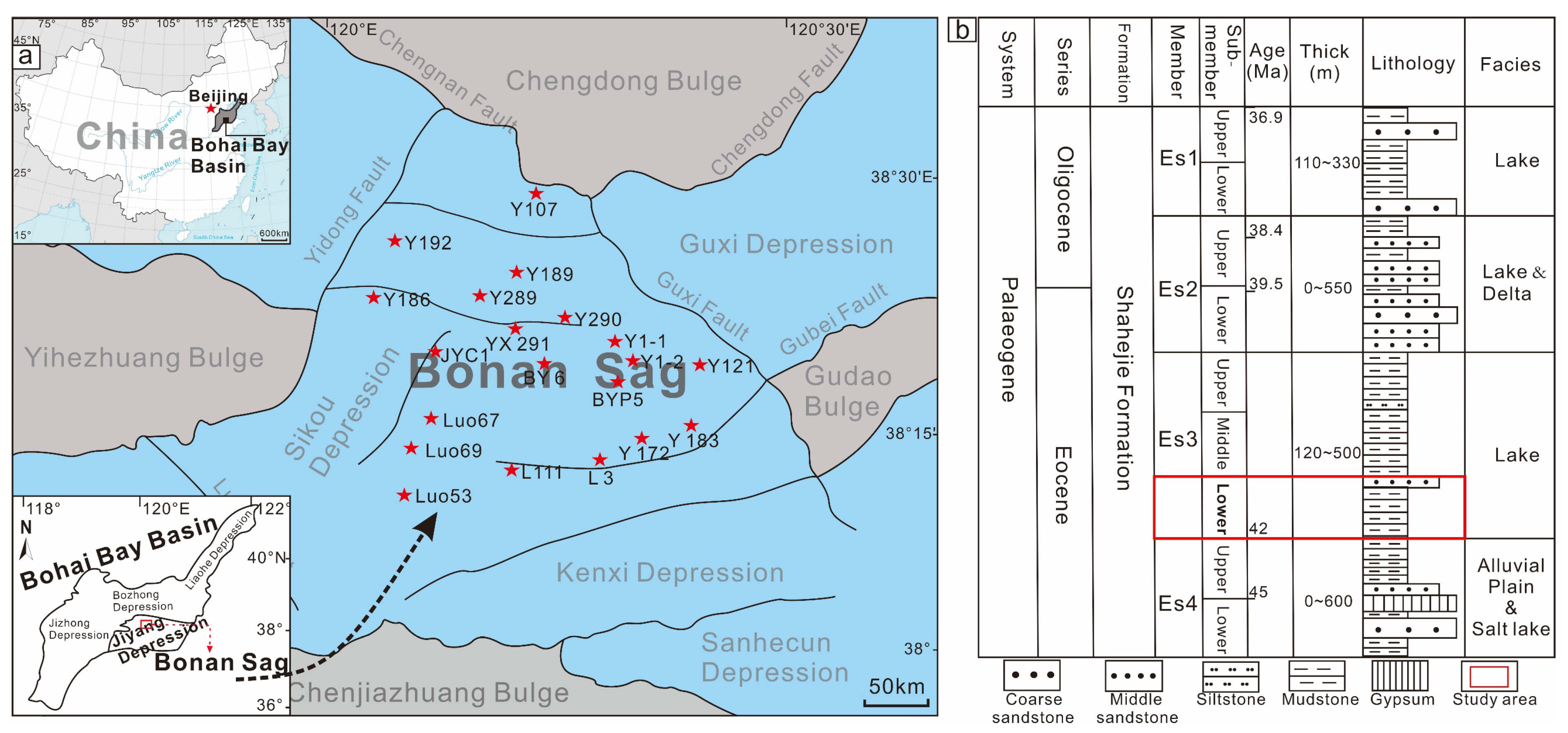
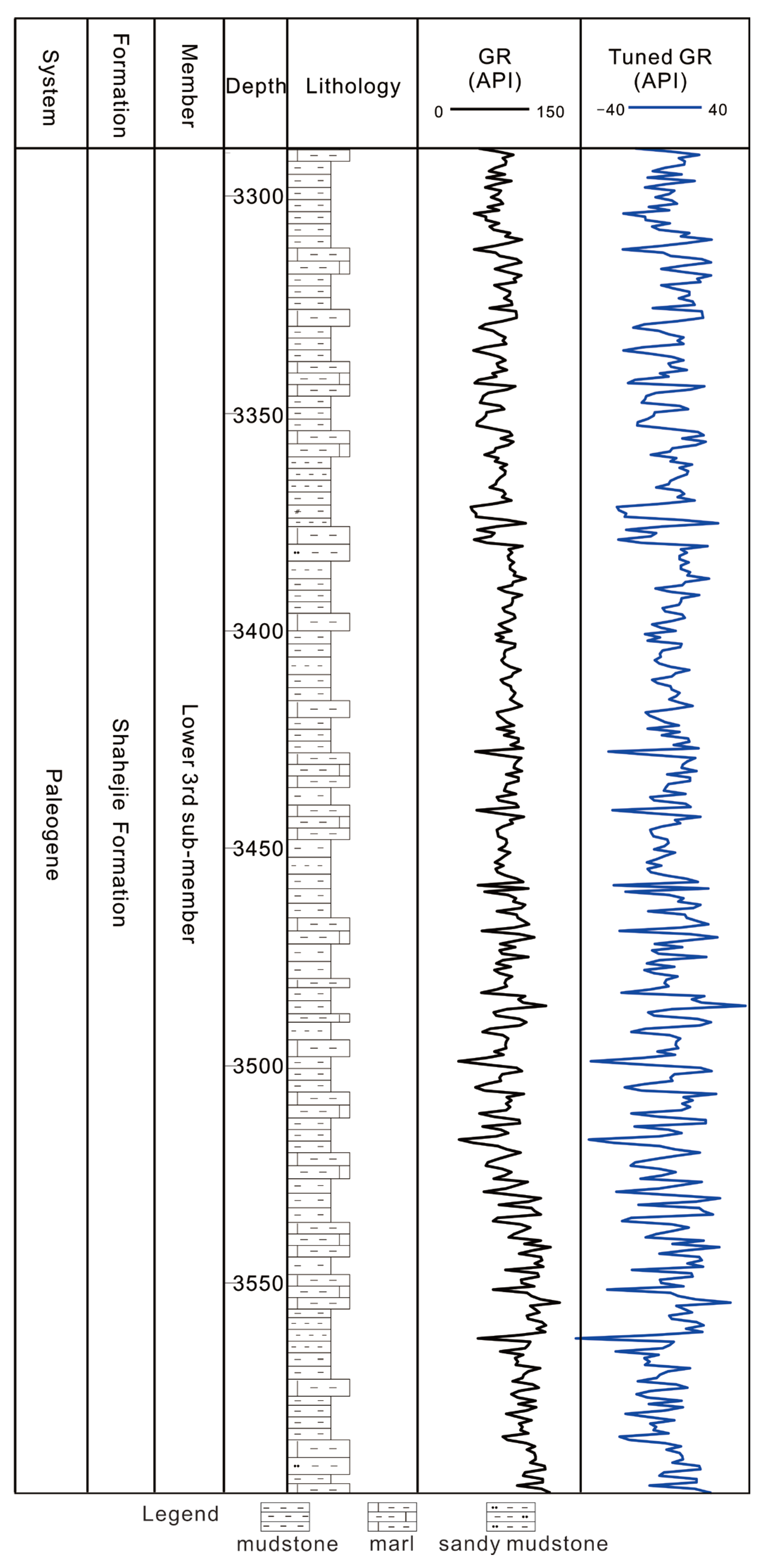
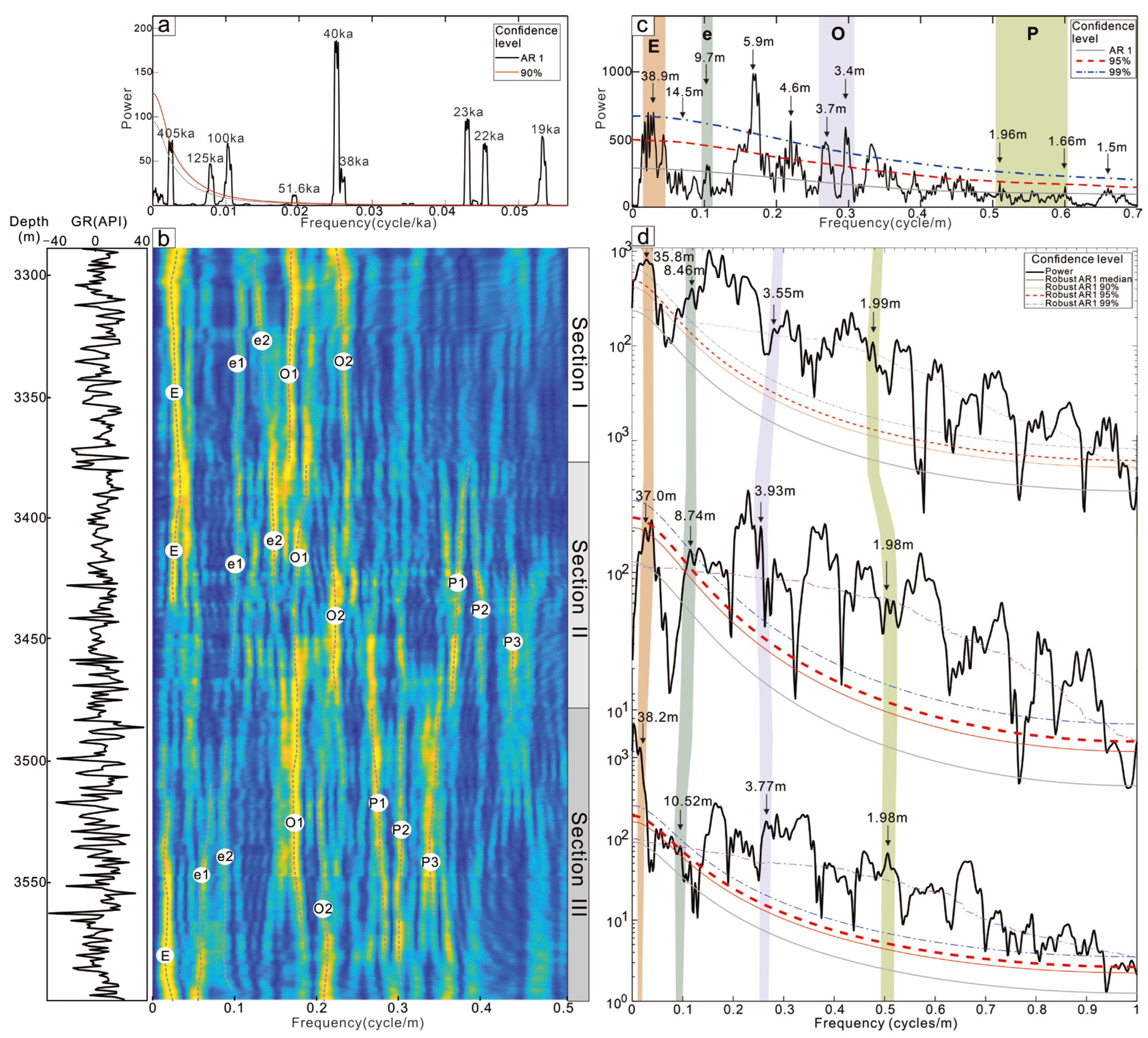
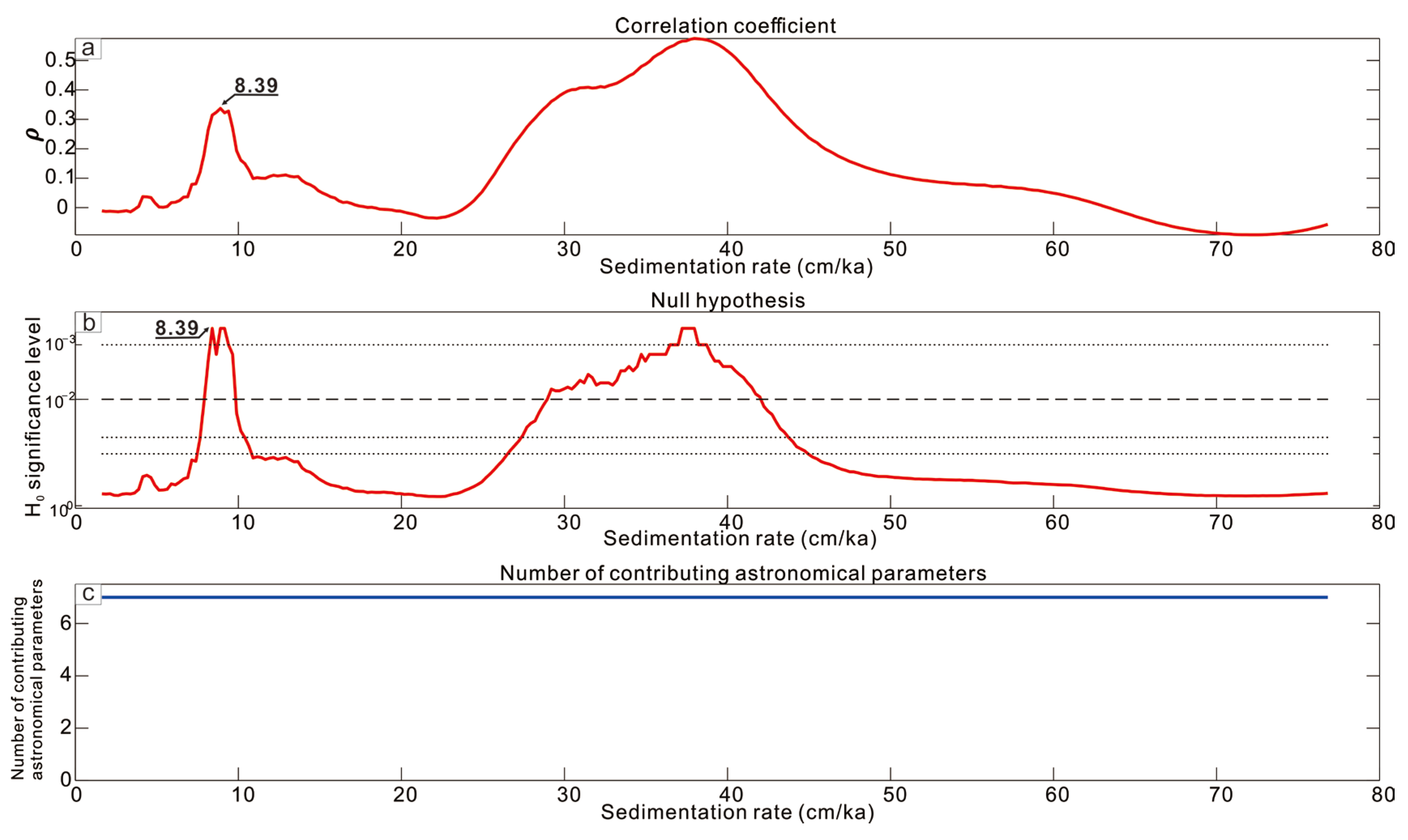
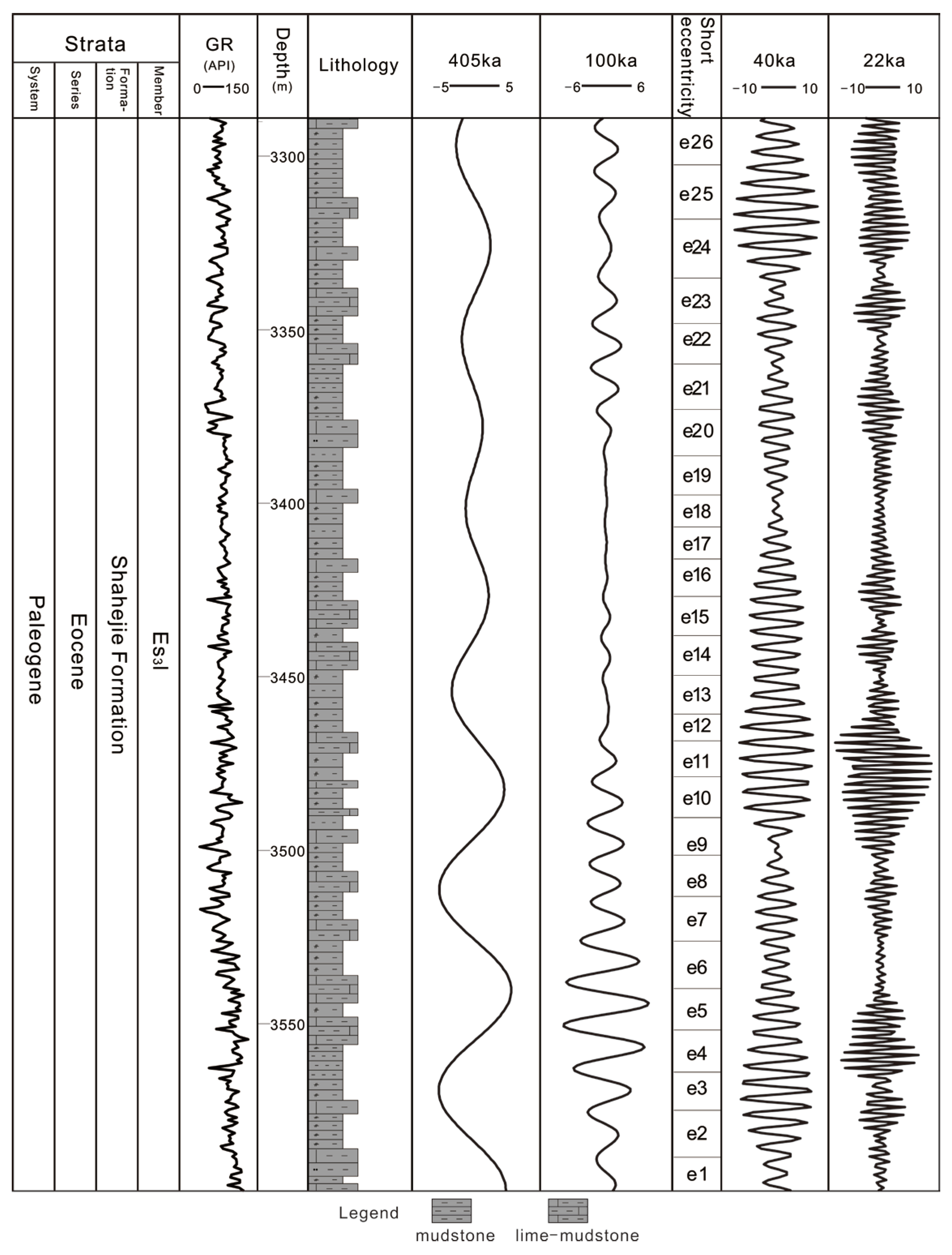
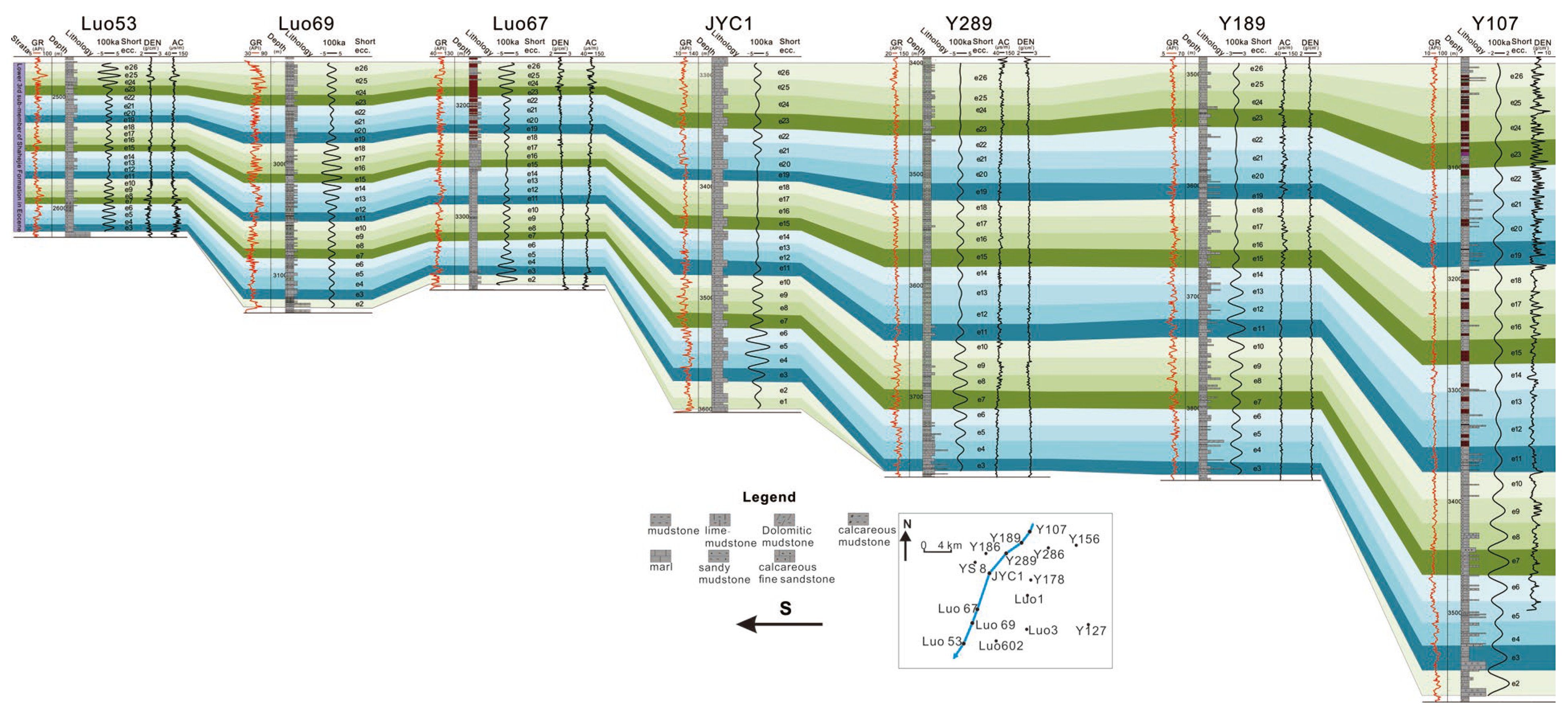

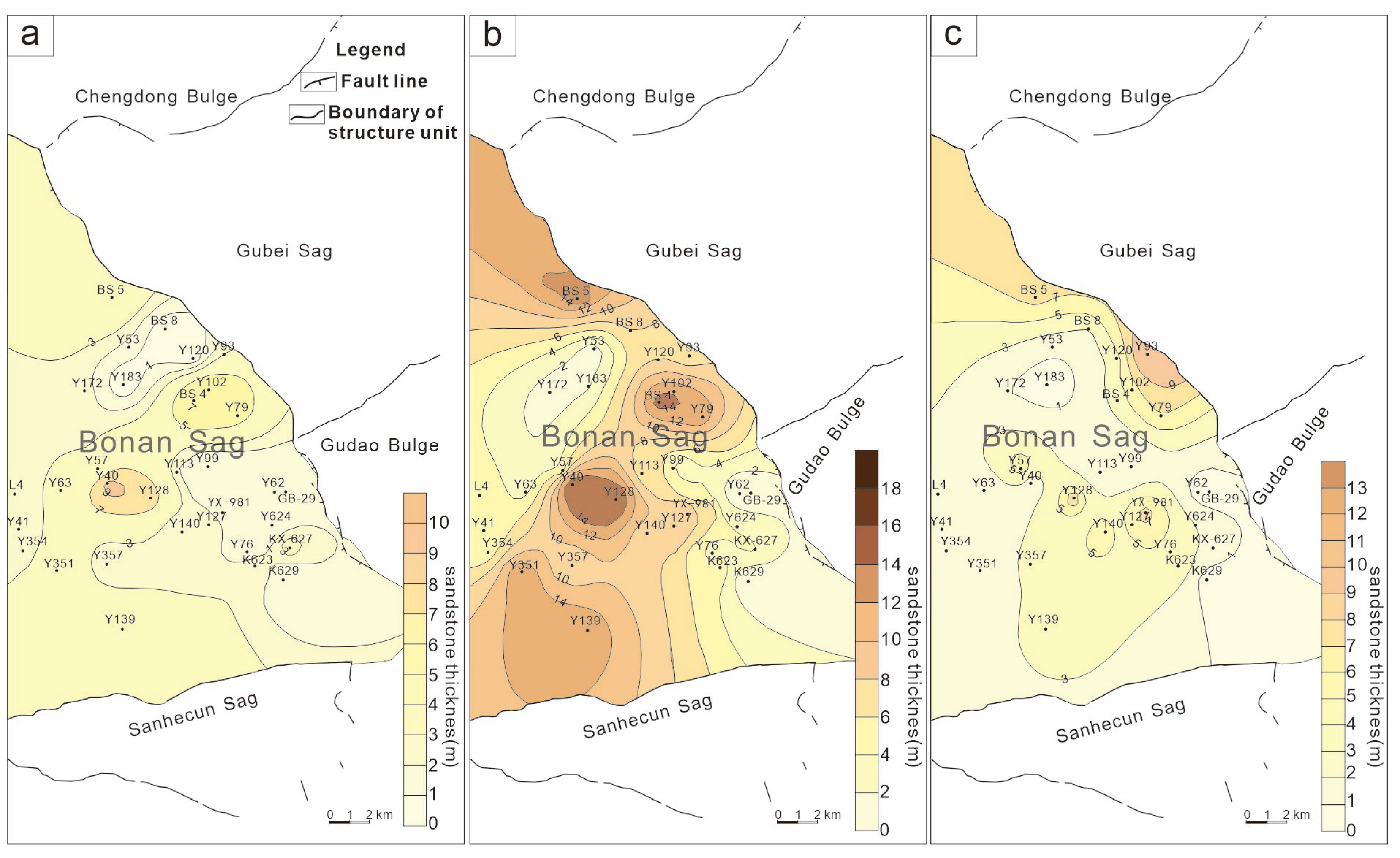
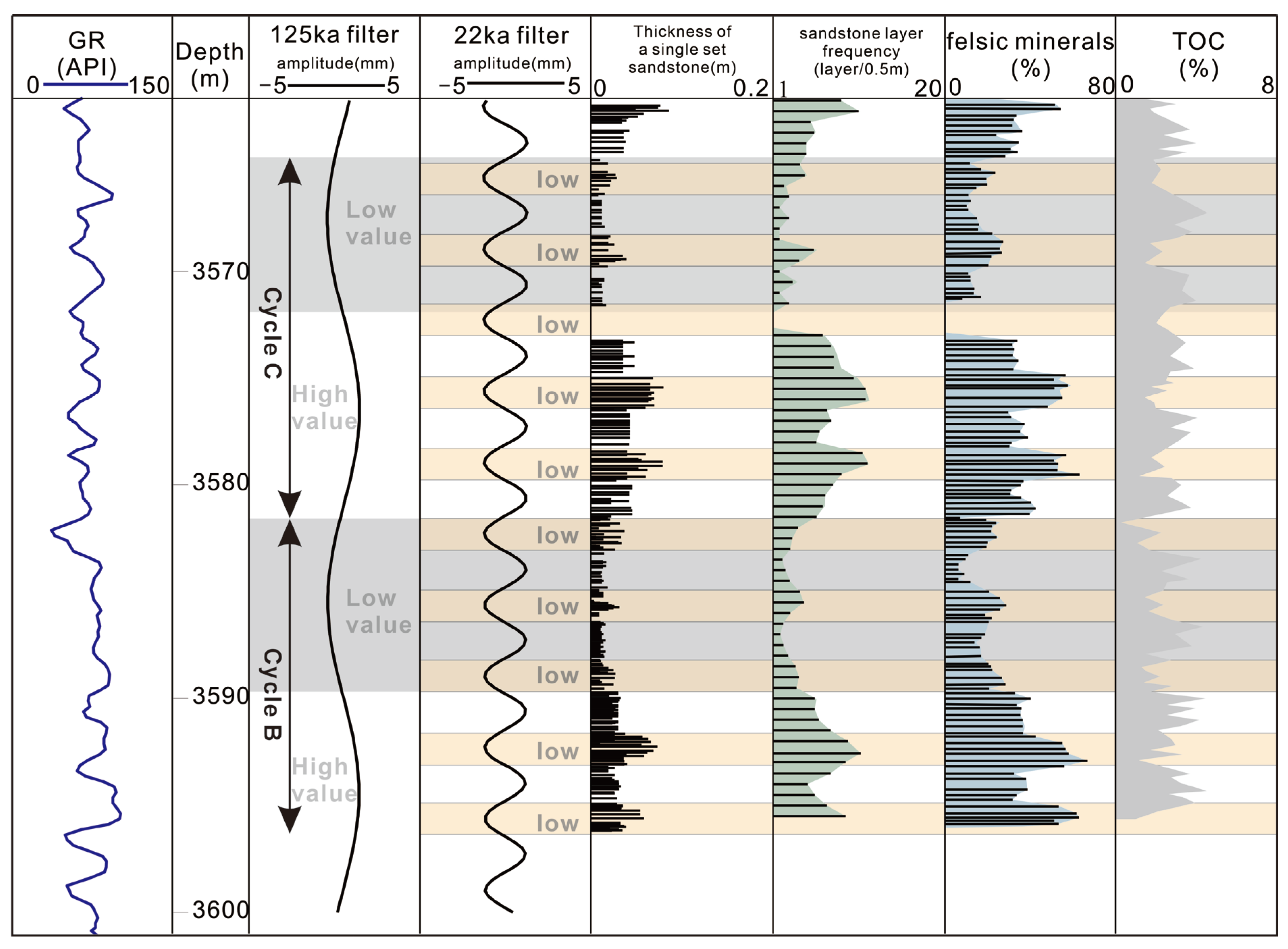
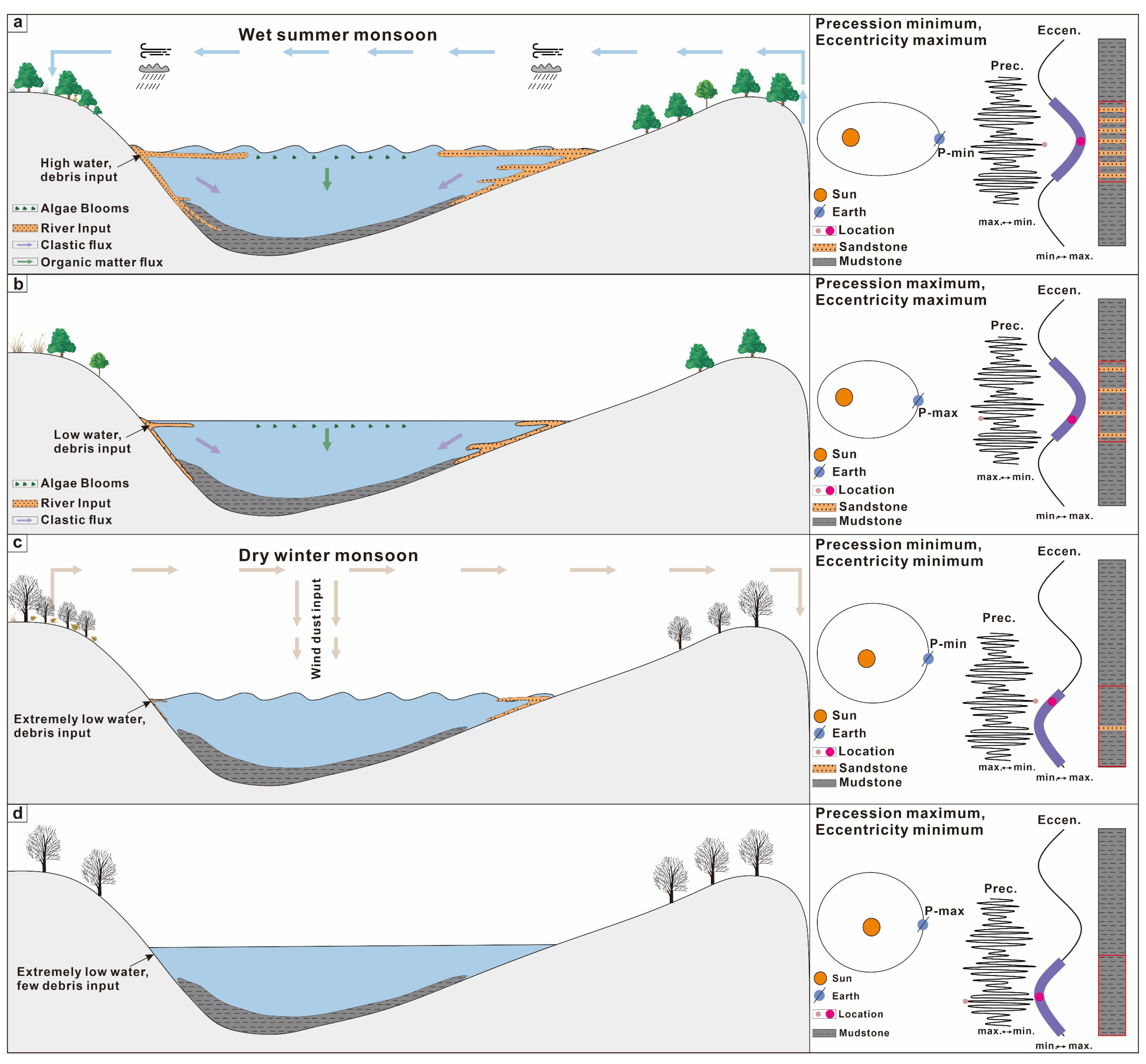
| 100 ka Short Eccentricity | 22 ka Precession | Thickness of Single-Layer Sandstone | Frequency of Sandstone Development | Felsic Minerals Content | TOC Content |
|---|---|---|---|---|---|
| Low value | Low value | Thin | Low | Low | Relatively high |
| High value | Extremely thin | Extremely low | Extremely low | High | |
| High value | Low value | Extremely thick | Extremely high | Extremely high | Low |
| High value | Thick | High | High | Relatively low |
Disclaimer/Publisher’s Note: The statements, opinions and data contained in all publications are solely those of the individual author(s) and contributor(s) and not of MDPI and/or the editor(s). MDPI and/or the editor(s) disclaim responsibility for any injury to people or property resulting from any ideas, methods, instructions or products referred to in the content. |
© 2025 by the authors. Licensee MDPI, Basel, Switzerland. This article is an open access article distributed under the terms and conditions of the Creative Commons Attribution (CC BY) license (https://creativecommons.org/licenses/by/4.0/).
Share and Cite
Zhang, J.; Zhong, Q.; Li, W.; Liu, Y.; Li, P.; Li, P.; Pang, S.; Yang, X. Astronomical Forcing of Fine-Grained Sedimentary Rocks and Its Implications for Shale Oil and Gas Exploration: The BONAN Sag, Bohai Bay Basin, China. J. Mar. Sci. Eng. 2025, 13, 1080. https://doi.org/10.3390/jmse13061080
Zhang J, Zhong Q, Li W, Liu Y, Li P, Li P, Pang S, Yang X. Astronomical Forcing of Fine-Grained Sedimentary Rocks and Its Implications for Shale Oil and Gas Exploration: The BONAN Sag, Bohai Bay Basin, China. Journal of Marine Science and Engineering. 2025; 13(6):1080. https://doi.org/10.3390/jmse13061080
Chicago/Turabian StyleZhang, Jianguo, Qi Zhong, Wangpeng Li, Yali Liu, Peng Li, Pinxie Li, Shiheng Pang, and Xinbiao Yang. 2025. "Astronomical Forcing of Fine-Grained Sedimentary Rocks and Its Implications for Shale Oil and Gas Exploration: The BONAN Sag, Bohai Bay Basin, China" Journal of Marine Science and Engineering 13, no. 6: 1080. https://doi.org/10.3390/jmse13061080
APA StyleZhang, J., Zhong, Q., Li, W., Liu, Y., Li, P., Li, P., Pang, S., & Yang, X. (2025). Astronomical Forcing of Fine-Grained Sedimentary Rocks and Its Implications for Shale Oil and Gas Exploration: The BONAN Sag, Bohai Bay Basin, China. Journal of Marine Science and Engineering, 13(6), 1080. https://doi.org/10.3390/jmse13061080





